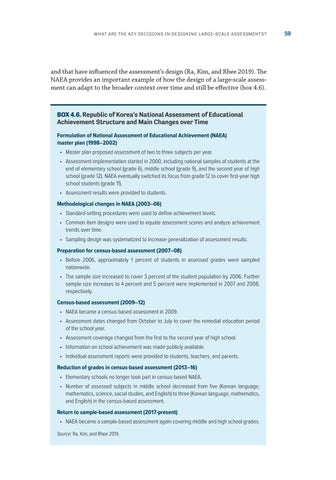What Are the Key Decisions in Designing Large-Scale Assessments?
and that have influenced the assessment’s design (Ra, Kim, and Rhee 2019). The NAEA provides an important example of how the design of a large-scale assessment can adapt to the broader context over time and still be effective (box 4.6).
BOX 4.6. Republic of Korea’s National Assessment of Educational Achievement Structure and Main Changes over Time Formulation of National Assessment of Educational Achievement (NAEA) master plan (1998–2002) • Master plan proposed assessment of two to three subjects per year. • Assessment implementation started in 2000, including national samples of students at the end of elementary school (grade 6), middle school (grade 9), and the second year of high school (grade 12). NAEA eventually switched its focus from grade 12 to cover first-year high school students (grade 11). • Assessment results were provided to students. Methodological changes in NAEA (2003–06) • Standard-setting procedures were used to define achievement levels. • Common item designs were used to equate assessment scores and analyze achievement trends over time. • Sampling design was systematized to increase generalization of assessment results. Preparation for census-based assessment (2007–08) • Before 2006, approximately 1 percent of students in assessed grades were sampled nationwide. • The sample size increased to cover 3 percent of the student population by 2006. Further sample size increases to 4 percent and 5 percent were implemented in 2007 and 2008, respectively. Census-based assessment (2009–12) • NAEA became a census-based assessment in 2009. • Assessment dates changed from October to July to cover the remedial education period of the school year. • Assessment coverage changed from the first to the second year of high school. • Information on school achievement was made publicly available. • Individual assessment reports were provided to students, teachers, and parents. Reduction of grades in census-based assessment (2013–16) • Elementary schools no longer took part in census-based NAEA. • Number of assessed subjects in middle school decreased from five (Korean language, mathematics, science, social studies, and English) to three (Korean language, mathematics, and English) in the census-based assessment. Return to sample-based assessment (2017-present) • NAEA became a sample-based assessment again covering middle and high school grades. Source: Ra, Kim, and Rhee 2019.
59

